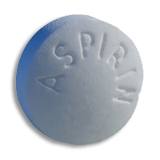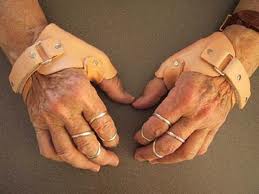|
Anti-Aging DevelopmentsAnti-Aging Developments - February 2011age-well.org > Anti-aging Discoveries > Anti-aging Developments - February 2011 Why you might want to Cut Back on WheatAnti-Aging Developments, February 24, 2011 --Amylopectin, the most common form of starch, is faster releasing and does not have the same positive effect on insulin as beans and oats. Wheat is high in amylopectin. So although wholemeal bread is better for you than white bread, if you want to remove the weight more quickly it is better to avoid wheat most of the time and go for breads and pasta made with other grains such as rye and corn. Wheat also contains a protein called gluten which forms a sticky substance in the digestive system (like the flour and water glue they used to use in schools). Because gluten is sticky and difficult to digest it encourages the growth of unfriendly bacteria which can produce toxic substances and gas. (Excerpt from the Book ‘Fat Around the Middle – How to Lose that Bulge for Good') Mobbing and Bullying in the Workplace is a Sign of the TimesAnti-Aging Developments, February 24, 2011 --It is unfortunate but age discrimination and bullying in the workplace is a reality in many countries in these difficult economic times. People who are approaching retirement age or even those who are approaching fifty are often seen as easy targets by bullies who want to use their age against them. As you age it is important to keep fit and active and and finding ways to manage your stress and avoid depression are necessary if you are to show you are still competent and able to deal with change. Try this link for further information on Mobbing and Workplace Bullying as well as links which will give you information on how to deal with it. Does Osteopenia Require Treatment?Anti-Aging Developments, February 23, 2011 --Not everyone who suffers from Osteopenia requires treatment, according to the Health Sciences Institute (US). Everyone experiences bone density loss as a natural part of aging. So you may have perfectly healthy bones, but just not quite as dense at 45 as they were at 35. That's osteopenia — a word dreamed up by World Health Organization (WHO) researchers. But once the word was out there, it became a "condition." And you know what they do with conditions. They treat them with drugs! Don't fall for it. It's not therapy and you don't need it. It's a marketing campaign, pure and simple. (Source: Health Sciences Institute E-Alert) Bee Pollen to Maintain a Healthy Urine Flow and Healthy Prostate
Anti-Aging Developments, February 23, 2011 -- The prostate is a walnut-sized gland located just below the bladder. It contributes to the fluid that carries sperm. With age some men have difficulties urinating - they have to strain in order to pee and can't empty their bladder completely, have to get up often at night to urinate and the flow seems blocked, If a man maintains a healthy-sized prostate, it will serve him well for as long as he lives. It may come as a bit of a surprise to you that concentrated pollen extract – can make men pee with more power. Pollen, the “seed” of flowering plants which allows them to reproduce, is chock full of vitamins, minerals, antioxidants, unsaturated fats, enzymes and other nutrients. Pollen extract is a “superfood” for bees – and for the prostate. Studies show bee pollen reduces DHT, the hormone that starts to ramp up in men as they get older. Low levels of DHT are critical for a healthy-sized prostate. When researchers in England gave it to men who were going to the bathroom a little too often and had a hard time peeing, 79 percent of them showed real improvement.2 Bee pollen also helps relax the smooth muscles lining the urinary tract. That means when a man has to pee, he can just relax and let it rip. Bee pollen is a huge help and is one of the newest, most innovative supporters out there today for the prostate. (Source: Dr. Al Sears, House Call Newsletter) Switch to Thai Rice to Avoid Arsenic Poisoning
Anti-Aging Developments, February 23, 2011 -- Ten percent of the rice sold in UK supermarkets contains ten times the levels of arsenic allowed in China, according to Dr. Marilyn Glenville, the UK's leading specialist in the nutritional approach to women's health care. Recently there have been a series of newspaper articles advising mothers not to give their babies rice milk because of a danger of arsenic poisoning. Dr. Marilyn Glenville reports in her weekly newsletter that she has always advised her patients against it, because of the high level of arsenic which can be found in some of the grain. Most rice contains some arsenic, a poisonous element, and arsenic is present in many foods, she explains. However, rise is grown in flooded fields, so the arsenic naturally present in the soil is absorbed by the plants through the water. Long-term exposure increases the risk of skin, lung, and bladder cancer, so the Food Standard Agency says that if you want to eat rice more than three times a week, consider switching to Thai or Indian grown rice, which have lower arsenic levels. (Source: Dr. Marilyn Grenville, email 15th February, 2011) Prescription Drugs Can be Robbing your Body
Anti-Aging Developments, February 16, 2011 -- Ibuprofen and aspirin can rob your body offolic acid according to Dr. Jonathan Wright's Nutrition and Healing Newsletter. When you run low on folic acid, you raise bad homocysteine, and reduce ‘happy’ brain chemicals, increasing your risk for cancer, depression and heart disease. Many of the over the counter and prescription medicines we take can rob our bodies of vitamins and minerals we need to keep healthy. Laxatives and antacids, for example, drain the body of calcium - run low on that and you can develop muscle cramps and brittle bones. Most blood pressure pills rob the body of magnesium. Run low on this mineral and you’re letting yourself in for muscle pain/tenderness, asthma, depression, heart disease and... wait for it, yes, high blood pressure, too! But the biggest culprits of them all. according to the Nutrition and Healing newsletter are the cholesterol-lowering drugs known as statins. These drugs will rob your body of CoEnzyme Q10 (CoQ10). More about this important nutrient will follow:---- (Source: Dr. Jonathan Wright's Nutrition and Healing Newsletter.) Are Corticosteroid Injections for Tendonitis working?Anti-Aging Developments, February 16, 2011 -- Should We Stop Using Local Injections Of Corticosteroids For Treatment Of Tendonitis?Dr. HS Diamond in Medscape reported On a review of clinical trials of local corticosteroid injections (cortisone shots) for tendinitis published in the Lancet The study found short-term benefits from local corticosteroid injection but no long-term benefit He goes on to say…the low toxicity of local corticosteroids and the rapid pain relief in tendinitis justifies their use if short-term pain relief is the goal. They may not be a good choice in patients with chronic or recurrent tendinitis. (As reported in February 2011 issue of Inside Arthritis Tips) Hand Splints May Ease Degenerative Arthritis
Anti-Aging Developments, February 16, 2011 -- Lynne Peeples writing in Reuters reports that hand splints may ease degenerative arthritis pain, according to a study in Arthritis Care and Research. Investigators analyzed 12 studies with about 500 patients. Although the splints usually did not improve strength or hand mobility, the splints had an effect on pain comparable to that achieved with anti-inflammatory drugs. Notably, in one study, hand pain was cut by 50% for patients who wore a rigid splint every night for one year. (As reported in February 2011 issue of Inside Arthritis Tips) Lower Back Pain May Be Inherited
Anti-Aging Developments, February 16, 2011 -- Salynn Boyles of WebMD reported that in an analysis of a database of more than two million people, lower back pain may be inherited. According to a study published in the Journal of Bone and Joint Surgery, "people with an immediate family member, such as a parent, sibling, or child, with disc-related low back pain were more than four times more likely to have low-back pain themselves. More modest increases in risk were associated with having a second- or even a third-degree relative with a diagnosis of herniated or degenerative disc disease." (As reported in February 2011 issue of Inside Arthritis Tips) TNF Inhibitors Reduce Diabetes RiskAnti-Aging Developments, February 16, 2011 -- Heidi Splete in Rheumatology News reported that Use of tumor necrosis factor (TNF) inhibitors, drugs that are used to treat inflammatory forms of arthritis such as rheumatoid arthritis was associated with a 60% reduction in the risk of developing diabetes. Researchers at the Geisinger Clinic in Danville, PA reviewed data from 1,287 adults with rheumatoid arthritis. 13 new cases of diabetes developed in the group who had used TNF inhibitors while 43 patients in the never used group contracted diabetes. (As reported in February 2011 issue of Inside Arthritis Tips) Fortified Cheese May Reduce Bone Loss In Elderly Women
Anti-Aging Developments, February 16, 2011 -- Laura Dean writing in Medwire reported, "Consumption of soft cheese enriched with vitamin D and calcium could reduce bone loss, and thus long- term fracture risk, in elderly women living in nursing homes," according to a study published in the Journal of Health Nutrition and Aging. Researchers "investigated the effect of a nutritionally enriched soft plain cheese on bone loss markers in 21 female nursing home residents," who had "low vitamin D" levels and a calcium intake "below 700 mg/day." The subjects consumed cheese "made with semi-skimmed milk, which was fortified with vitamin D3 and milk calcium. The researchers "found that the cheese supplementation increased the women's calcium and protein intakes by 51% and 33%," respectively. (As reported in February 2011 issue of Inside Arthritis Tips) Age at onset of puberty predicts adult osteoporosis riskAnti-Aging Developments, February 16, 2011 -- A team of researchers determined that the onset of puberty is the primary influence on adult bone mineral density. Later puberty resulted in lower bone mass and increased the risk for fracture, and length of puberty did not affect bone density, they found. The Bone Mineral Density in Childhood Study is an ongoing multi-center study examining bone development in healthy US children and adolescents. For this analysis, the researchers studied 78 girls and 84 boys who had just entered puberty and followed them until they reached sexual maturity. "Puberty has a significant role in bone development," Vicente Gilsanz, MD, PhD, said in a press release. "During this time, bones lengthen and increase in density. At the end of puberty, the epiphyseal plates1. close, terminating the ability of the bones to lengthen. When this occurs, the teenager has reached their maximum adult height and peak bone mass. We found that early puberty was associated with greater bone mass, while later puberty resulted in less."Timing of puberty According to results of the study, the age of onset of puberty was a strong negative predictor of DXA2. bone measurements at skeletal maturity. This finding was independent of bone values at the start of puberty, as well as the length of puberty. Further, the negative relationship was observed for all bone mineral content and BMD3. measurements at all skeletal sites in boys and girls. "On average, healthy girls starting puberty a year earlier had approximately 5% greater bone mineral content measures and 2.5% greater BMD values at skeletal maturity, but those starting a year later had 5% and 2.5% less," Gilsanz and colleagues wrote in The Journal of Pediatrics. "Similar findings of a slightly smaller magnitude were observed in healthy boys."Predicting adults bone mass, density The researchers said these findings "provide further evidence of the importance of timing of pubertal commencement as a strong independent predictor of bone mass and bone density in healthy young adults." In addition, the data may be of interest to health care professionals who consider medical intervention to delay puberty in adolescents with short stature. Gilsanz and colleagues concluded that prolonging the growth period by delaying puberty may have "unexpected consequences" later in life and may result in a deficit in peak bone mass. "Because the rate of decline in bone mass in adulthood is approximately 1% to 2% per year, a 10% to 20% difference in bone density because of the normal variations in the timing of puberty corresponds to an additional 10 to 20 years of protection against the normal age-related decline in skeletal mass," the researchers wrote. The results open the door to further studies to evaluate whether deficiencies in peak bone mass can be prevented with nutritional, mechanical or pharmacological intervention in adolescents with delayed pubertal commencement, they said. Notes: 1.The epiphyseal plate (or epiphysial plate, physis, or growth plate) is a hyaline cartilage plate in the metaphysis at each end of a long bone.2.DYA - or Dual-energy X-ray absorptiometry - is the most widely used and most thoroughly studied bone density measurement technology. 3.BMD = Bone Mineral Density (Source: Article by Mark A Sperling MD in Algae Cal Newsletter, February 2011) Power Foods for Weight Loss
Anti-Aging Developments, February 16, 2011 -- Wild salmon and other fish rich in omega 3 such as trout, mackerel and sardines are a good choice if you want to lose weight. Omega 3 fatty acids have an anti-inflammatory effect in the body and can increase our cells' fat-burning abilities. Other good choices are nuts and seeds. Carrots, apples, oats, and beans are also good choices if you are hoping to lose weight. All these foods are a good sources of fiber and “resistant starch”, which means that the body uses a lot of calories to process them. Unlike foods that cause a blood sugar rush, such as sugar rich food and refined carbohydrates, sugar from these foods will release slowly into the blood stream. This is the reason that after eating them you will feel fuller and more satisfied and therefore eat less calories. (Source: Dr. Marilyn Grenville, email 15th February, 2011) New Test May Help Detect Vitamin D Deficiency EarlierAnti-Aging Developments, February 15, 2011 -- A new diagnostic vitamin D assay to be released in Europe may help to detect early deficiency, and could help to provide more accurate data for dieticians and researchers. Developed by the diagnostic lab technology company Abbott to detect the amount of 25-hydroxy vitamin D, the ARCHITECT 25-OH Vitamin D is a new diagnostic test to measure levels of vitamin D in blood using an automated instrument system. Abbot announced "Conformité Européenne" (CE) European Conformity in English, marking for the assay, which is intended for the assessment of 25-hydroxy vitamin D in human serum and plasma to determine vitamin D status, but added that currently the test is not approved for use in the US. Abbot said the assay will provide a quick and accurate gauge of vitamin D status in blood samples - which may provide greater opportunities for preventive and therapeutic interventions in at risk populations.D deficiency "Vitamin D deficiency is recognized as a global health problem, and vitamin D supplementation should be considered for all people at risk of vitamin D deficiency," said Dr Jean-Claude Souberbielle, of the Université Paris. He added that determination of the serum vitamin D concentration and supplementation according to the measured deficiency level is important for patients with osteoporosis, chronic kidney disease, abnormalities in absorbing food nutrients, and more generally, in those with a disease or a treatment that may impair bone health. The UK National Institute of Health (NiH) said that whilst testing for levels of 25-hydroxy vitamin D is currently the most accurate way to determine vitamin D levels, many assays that are used can be notoriously inaccurate. "As a major diagnostic lab, serum 25-OH vitamin D has become an increasingly important diagnostic marker to us," said Dr. Frans AL van der Horst, from the Reinier de Graaf Group, Netherlands. Brian Blaser, senior vice president, diagnostic operations for Abbott said that the new vitamin D assay is "a valuable and convenient addition" which provides an automated test for samples that may previously have been sent to outside reference labs. (Source: reproduced from Algae Cal Newsletter, February 2011) Benefits of Apple Cider Vinegar
Anti-Aging Developments, February 14, 2011 -- Apple Cider Vinegar has long been known to have enormous value for your health. Vinegar is made by the fermentation of fruit, in this case apples, and it is this fermented fruit acid that contains a host of beneficial vitamins and minerals, including potassium, magnesium, calcium, iron, and other trace minerals, as well as pectin. It is thought that pectin, which is a fiber, can attach itself to cholesterol globules and remove excess from the body. It is also thought to help with the thinning and circulation of blood and in reducing high blood pressure. Cider vinegar is known traditionally as a powerful detoxifying food as it breaks down mucus and phlegm in the body. It has also been used as a remedy for arthritis as it is supposed to be able to break down the acid crystals that can harden in the joints causing pain. Research has shown that when vinegar is added to food, calcium absorption is increased. It is also helpful in controlling negative bacteria, so adding three cups of pure apple cider vinegar, together with a few drops of tea tree essential oil, to your bath can be very helpful when you have a vaginal infection. (Dr. Marilyn Glenville email 15 February, 2011) Anti-Aging Developments, Anti-Aging Developments, Anti-Aging Developments, Anti-Aging Developments age-well.org > Breaking News > Anti-aging Developments - February 2011 Top of Anti-aging Developments - February, 2011 |
Translate this Site
Search This Site
Loading
Subscribe to E-Zine
Support this Site
|
Holiday SpecialsFor Holiday Specials at Amazon, Click Here
|
| |||||





